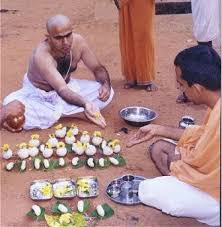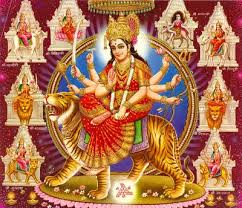Navratri - the nine sacred nights, is a festival celebrated, with great fervor both religiously and socially, all over India to commemorate the victory of the good over the evil. The celebrations spread over nine auspicious nights. According to
Hindu belief, ‘The Embodiment of Divine Power' (Para-Shakti), has three important manifestations: Maha- Saraswati (Goddess Of Knowledge) (Satwic), Maha-Lakshmi (Goddess of Wealth and Prosperity) (Rajasic) and Mahakali or Durga (Warrior Goddess) (Tamasic). During the Navaratri, the Goddess "Para-Shakti" is struggling to overcome the forces of vice, wickedness and egoism and on Vijaya Dashami (Dasara, the tenth Day commemorating victory), she conquers and destroys all evil forces (i.e. bringing to an end the atrocities of Asuras like Mahishasuran, Shumban, Nishumban, Madhukaidapan, Thumralochanan and Rakthabheejan). Para-Shakti is all-pervasive, omnipotent, infinite as well as all-knowing.
Step 1
Navaratri - Devoted to Durga, Lakshmi and Saraswati. The Navaratri has been divided into three components. The first three days are dedicated to the worship of Durga, the next three days to the worship of Lakshmi and the last three days to the worship of Saraswati. On the occasion of Navaratri, we invoke three kinds of potential energies--Ichchaa Shakti (will power), Kriyaa Shakti (the power of action) and Jnana Shakti (the power of discrimination) from Goddess Durga, Lakshmi and Saraswat. On the tenth day (Vijaya Dasami), we offer the valedictory worship to mark the victory of good over evil by Durga. It is a festival of thanksgiving. Gratitude is divine. Ingratitude is demonic.
Step 2
Vasant and Sarat Navaratris. In North India, people celebrate two Navaratris - Vasant and Sarat. Vasant Navaratri falls during April-May (Hindu Calendar month Caitra) and Sarat falls during September-October (Hindu Calendar month Ashwin). The ninth day of Caitra is doubly auspicious and is celebrated as the birthday and marriage day of Lord Rama (Rama Navami). In South India, Sarat Navaratri is celebrated with the dates falling in Shukla Paksha, a day after the new moon in Puratasi month (
Tamil Calendar), which is September-October month in the Western calendar.
Step 3
Golu and its philosophy. In Tamil, Nadu Navarathri is celebrated by setting up ‘Golu' in a corner of every home (i.e. a gallery of handcrafted dolls representing major deities, scenes from everyday life, thematic doll sets representing mythological events or even modern day happenings and so on). In Tamil, Golu means a sovereign sitting in his royal durbar. The underlying belief in arranging these Navratri dolls on the tier is to depict that Goddess Durga or Mahishasuramardini is sitting in her Golu, prior to the slaying of the demon Mahishasura.
Step 4
Kalasa Puja. The housewives commence golu with "Kalasam puja." Instead of icon or photo we represent the goddesses in the form of kalasam. What is Kalasam? The Hindu house holds will always represent God or Goddesses in kalasam. For Kalasam, they will choose brass or silver pot and fill the brass or silver pot with water. After this, they will place a coconut amidst mango leaves on top of the pot.
Through the Kalasa puja mantra, they will invoke the power of goddess Durga or Parashakthi to come reside in kalsam or pot. It is called 'Avahanam.' After this puja it is believed that goddess Durga will be reigning our households for the entire nine days. She is the prime deity of Navaratri. So they attach more importance to this Kalasam and do kalasa puja.
After this puja, the Kalasam is kept in the golu i.e. first and foremost place and will remain fresh for the whole of nine days. During these nine days, the pot or Kalasam is decorated with new clothes, flower and sandal paste. Daily prayer, invocation songs, offerings, etc. will be performed with devotion. Once the festival is over, we will perform some rituals and remove kalasam and pour water in a well or pond. After this, everything comes to normalcy.
Our Mantra is powerful and invokes the goddess to reside in the pot full of water. For those who feel it difficult to understand 'Kalasa puja', it is a simple ritual to represent goddess PARA SHAKTHI in a pot or kalasam.
Step 5
Number of tiers and steps in arrangements. Golu means display. Goddess is present in our home during these nine days. The house holds organising 'GOLU' will prepare the display
furniture either in metal or in wood. The furniture or golu stand will have nine steps or tiers. The furniture or golu stand is readily available in the market. The slanting steps are like our door steps or staircase steps. Imagine a furniture is designed to display dolls in graded steps or tiers.
The furniture or golu stand has 9 tiers or steps. It is significant that the Navaratri Golu is set up with the arrangement of dolls on an odd number of steps (usually 3,5,7,9). The counting of the first step begins from top and proceeds to the bottom most step. The top most is step one, the next one is step two and the step nine is the bottommost one.
Maximum number of tiers in which dolls are arranged are 9 depending on time and space constraints. The golus show different themes in different homes - from the elaborate, extravagant ones to the simple, traditional and artistic ones. Year after year the women folk enthusiastically organize these dolls as per their tastes. Yet there are beliefs and conventions in arranging dolls in respective steps:
Tiers 1-3: You are expected to arrange Kalasam on the first tier or step. The first tier or step begins on top of the display furniture (golu stand). Goddess Durga or Mahishasuramardini, Maha Lakshmi, Maha Saraswati, Siva, Vishnu, Brahma and all other gods and goddesses occupy tier one to three. You may keep Dasavatharam set.
Tiers 4-6: Counting from top to bottom. You are expected to organize the next three steps to saints like Azhwars, Nayanmars, Guru Raghavendra, Sai Baba, and the like and you may even locate men and women of importance, i.e. national leaders like Mahatma Gandhi, Ramakrishna Paramahamsar, Swami Vivekananda etc.
Tier 7: Counting from top to bottom. You are free to organize sets of dolls on themes like family, marriage, festivals like Deepavali, Rama Navami, Krishna Jayanthi, etc.
Tier 8: Counting from top to bottom. You may organize sets of dolls according to your imagination and creativity. You may arrange various businesses and crafts, say for example your Chettiar dolls sitting in his business shop surrounded by grocery items like rice, pulses kept in bags or other utensils.
Tier 9: Bottom-most tier. You have the liberty to arrange the traditional wooden dolls called (Marapachi) - covered and decorated with glittering dresses. So also you may keep dolls of fish, tortoise,
reptiles, birds, lion, tiger, cow, bulls, etc.
Step 6
Nine days rituals. You may invite your friends and relatives to view your golu. Every day you are supposed to offer sweet pongal, sweets, sundal (boiled dhall with spices), etc., as naivedhyam and distribute among friends and relatives. Every day, you may dress up your children with fancy dresses depicting Lord Krishna, Devi Lakshmi or Devi Saraswati and so on. You may offer clothes, coconut, fruits, sweets, small
mirror, kumkum, turmeric, comb, beetle leaves with supari to married woman folks (Sumangalis).
Conclusion. On the 10th night after the ceremonial art and prayers, the dolls are put to ‘sleep.' You may pack up the dolls and preserve them for the next year golu.

 The man who sells a television set does not tell you the intricate scientific principles that make it work.
The man who sells a television set does not tell you the intricate scientific principles that make it work. 














